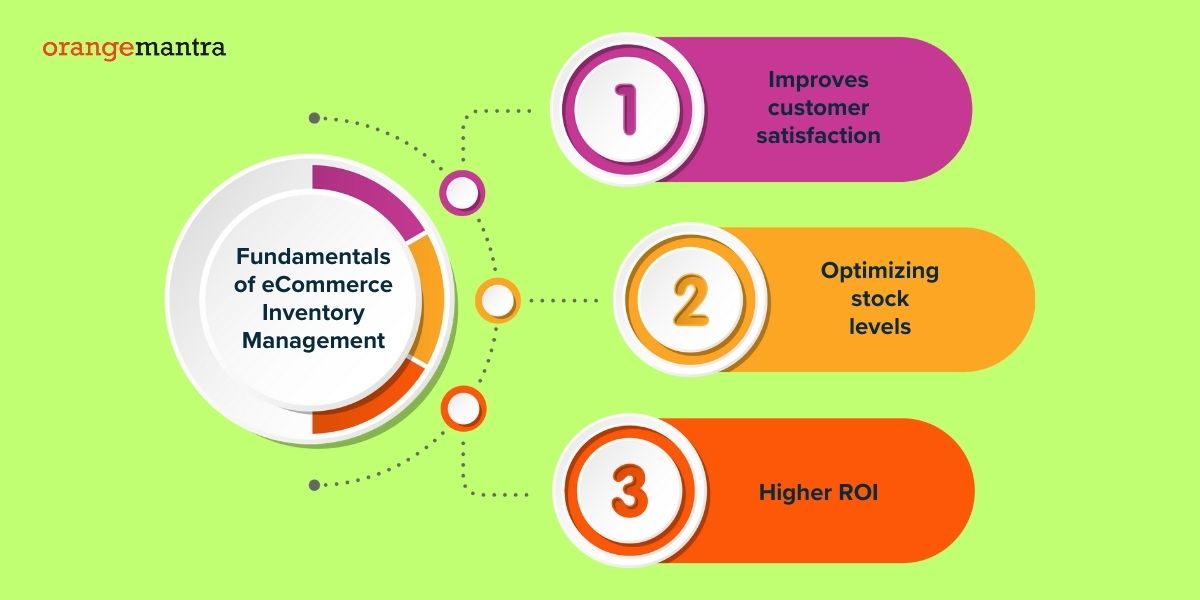69% of shoppers will abandon their purchase if their desired product is out of stock. On the other hand, if you overstock your inventory, it could lead to reduced profitability.
The competition in eCommerce is fierce. Managing your eCommerce inventory is one way to survive, even thrive. You cannot rely on assumptions; good inventory management requires meticulous planning, like many professional ecommerce website development companies do.
Fortunately, there are inventory management strategies that you can use to smash your quarterly sales. Want that sense of accomplishment? Read this article to know the secrets for effective eCommerce inventory management.
Understanding the Fundamentals of eCommerce Inventory Management

This section will cover the basic fundamentals for an eCommerce business. If you want to read the strategies, jump onto the next section below.
As compared to a traditional retail store, eCommerce businesses oversee the stock in multiple warehouses. These warehouses could be in the same location or spread apart. Inventory management helps in –
- Improves customer satisfaction, resulting in good reviews and repeated purchases.
- Optimizing stock levels, preventing stockouts.
- Higher ROI, allowing you to invest in business growth.
These fundamentals can help manage your stock levels, while keeping your costs in check.
7 Strategies for eCommerce Inventory Management
If you’re a B2B company, managing your inventory can be challenging. To help you in making this process easier, here are 9 foolproof tactics you can use –
Demand Planning: Forecasting eCommerce Needs
Predicting product demand is tough. Fortunately, demand planning can help in forecasting customer demand and ensure products are available whenever needed. This in turn reduces excess stock. Key advantages include –
- Future sales and seasonal fluctuations
- Stock level requirements
- Forecast customer demand.
Procter and Gamble (P&G) used advanced demand planning tools to predict customer behavior. This helped them deliver products on time and keep track of availability.
ABC Inventory: For Smarter eCommerce Decisions
One of the inventory management techniques splits products into 3 categories, depending on their importance. From improving inventory accuracy to relocating resources effectively, the benefits are tremendous. Here are the 3 categories:
- Category A: Most valuable product contributing to the most profit.
- Category B: Mix of the most and least valuable products
- Category C: For smaller transactions.
This is a great solution for reducing excess storage costs by optimizing bulk stock. Samsun is one of the companies that used this technique to reduce their production delays.
Drop shipping: A Unique Approach
66% of consumers prefer drop shipping services because they can choose their payment options. It’s an order fulfillment method where the supplier ships the products directly to the customer. Top 3 advantages it offers –
- Avoid the headache of eCommerce stock management
- Avoid warehouse costs.
- Provide a greater product variety without stressing over unsold stock.
Many eCommerce businesses rely on Shopify to provide drop shipping services. Additionally, this industry will gain $558 billion by 2025.
Just in Time (JIT): Order as Per Requirement
When you have a tight collaboration with retailers, suppliers, and manufacturers, you can manage your orders easily. Quality of the products is given the highest priority in JIT technique. Advantages include:
- Ideal for fast-moving and high-demand products.
- Reduces storage costs by removing unnecessary inventory headaches.
- Improve cash flow that would be stuck in excess stock.
Apple uses these inventory management techniques to manage their supply chain by relying on independent manufacturers to produce and deliver components as and when needed.
Safety Stock: For Handling Unexpected Stress
Safety stock is calculated based on factors such as demand variability and desired service level. When you maintain appropriate stock levels, you reduce stockout risks which leads to customer demand fulfilment. Advantages include:
- Regularly reassess safety stock levels to reduce costs.
- Balance customer satisfaction and inventory costs efficiently.
- Calculate your stock based on sales and supplier reliability.
Manufacturing companies like bicycle repair shops will keep spare parts in handy, especially when there’s a sudden rise in orders.
Storage and Routing
In inventory management for eCommerce, storage and routing tell you how and where your products are being stored. This technique uses advanced algorithms for storage optimization and routing orders. Key strategies include:
- Improved Warehouse Efficiency: Ensures your high-priority items are easier to grab, so workers can grab them faster.
- Inventory segmentation: Group similar products together so that it’s easier to find them.
- Cross Docking: Move things directly to outgoing trucks for delivery without wasting time.
Amazon and FedEx use this system for timely package delivery, which reduces their overall transit time and increases customer satisfaction.
Stock Takes
When you conduct a stock take, you double check if your physical stock matches with your inventory records. This practice can help you maintain accurate inventory records. Top 3 advantages include:
- Identify discrepancies and improve your inventory management.
- Areas of improvement on your inventory management for eCommerce.
- Remove damaged or expired products.
Ikea and Zara are companies that have used stock take techniques. With regular stock checks, they were able to update their inventory records and optimize their storage space.
Choosing the Right eCommerce Inventory Management for Your eCommerce Needs
We know that managing an inventory can be challenging, especially if you’re a B2B eCommerce developer. Having a structured inventory management system ensures
- Human errors are reduced
- Track stock levels in real time
- Automate tasks like reordering stock
- Integrate with sales channels like Shopify, WooCommerce, and Amazon
Before finalizing your inventory management in eCommerce, keep these factors in mind:
- Business Size: A simple solution is great for smaller businesses. The bigger the company, a multi-functional system is required.
- Budget Allocation: Different platforms will offer different pricing plans, catering to all business sizes.
- Automation Features: It’s advisable to use platforms that can automate stock and alert you about low stock.
- Integration Features: Ensure that your inventory management system works smoothly with your eCommerce platform.
Here are the 3 best eCommerce inventory management solutions that you can use:
NetSuite
Ideal for: Large and enterprise-level businesses, with complex inventory needs
A cloud-based solution, it’s ideal for businesses that deal with large warehouses spread across multiple locations. Advantages –
- Deep analytics for optimizing inventory control
- Inventory tracking for warehouses in multiple locations
- Alerts to prevent out of stock
Zoho
Ideal for: Mid and small businesses looking for budget-friendly options.
It’s an affordable and easy-to-use solution that helps in streamlining orders and works well with different sales channels. Advantages include:
- Barcode scanning and serial number tracking for accurate tracking
- Multi-channel selling integration with Amazon, eBay, and Shopify
- Real-time updates to prevent overstocking
Trade Gecko
Ideal for: Growing B2B eCommerce business
It’s a powerful cloud-based eCommerce business that can handle multi-channel inventory tracking and automated order management. It’s a good solution for businesses looking for a solution that grows with them. Advantages include:
- Smooth integration with Amazon and Shopify
- Automated stock updates
- Centralized inventory tracking
Wrapping Up
Investing in the right eCommerce platform helps your business tremendously. It can take the load off your shoulders by alerting you about low stock levels and automate mundane tasks. However, be mindful about the pros and cons of each inventory management solution before you finalize your decision.
However, if you’re confused and need additional help – Our team can help you get started in B2B eCommerce Developmet Services. From eCommerce inventory control to selecting the inventory management platform, we got you covered.
Drop us a message or give us a call. Let our expert team guide you in eCommerce inventory management.
Frequently Asked Questions
Q1. What are the inventory management techniques used in the eCommerce industry?
Ans 1 – Demand forecasting, real-time monitoring techniques, and automated reordering are some of the common techniques used in the eCommerce industry.
Q2. What is the ABC analysis of inventory management?
Ans 2 – It’s an inventory eCommerce technique that classifies products into 3 categories, depending on its importance (Category A) and manages the least priority items (Category c).
Q3. What is the inventory model of e-commerce?
Ans 3 – In an inventory-based e-commerce model, the company purchases, owns, and manages all products sold on its platform. They take full responsibility for logistics, warehousing, and order fulfillment to customers.























